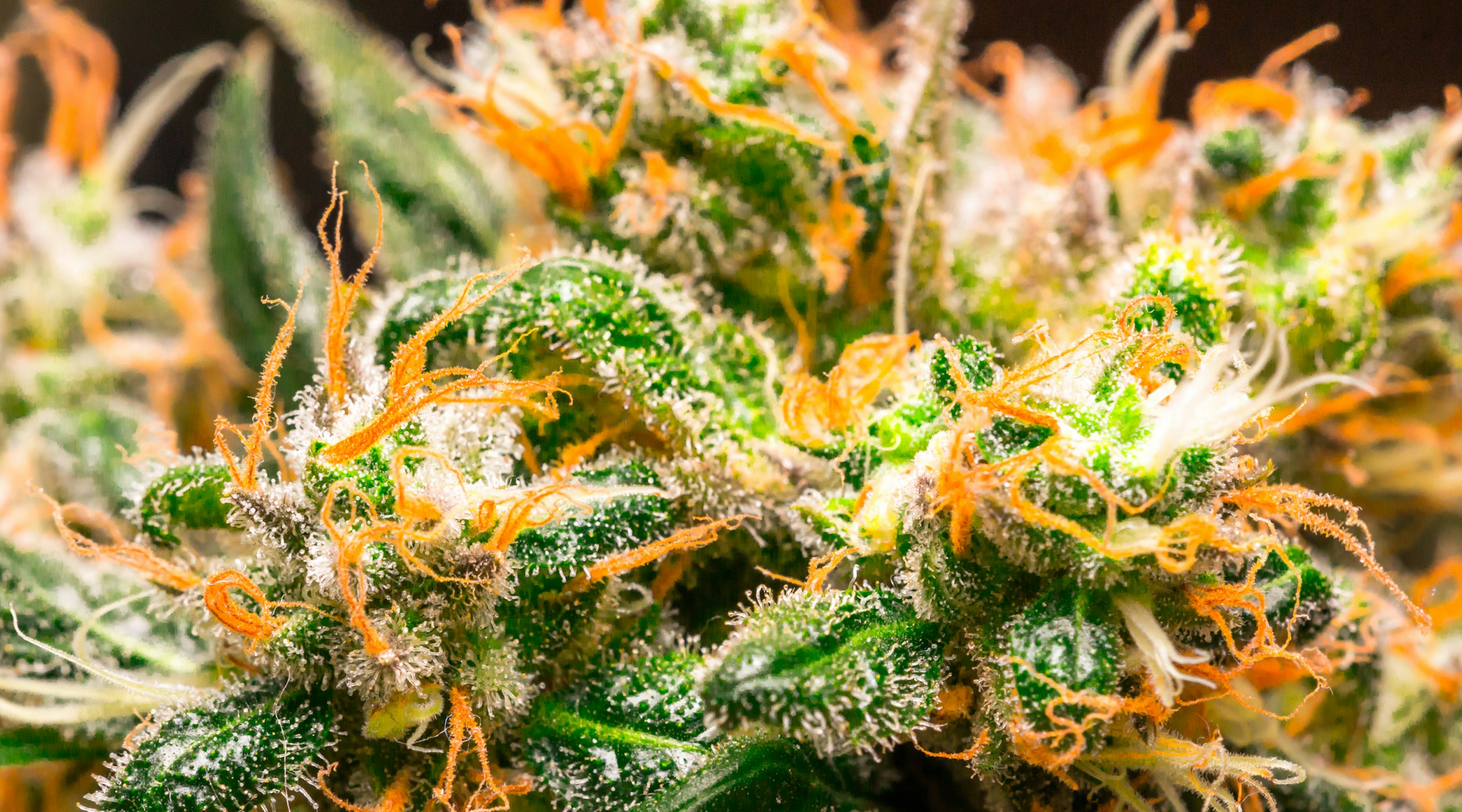Beyond aroma: How does myrcene enhance medical cannabis?
7 min read
Sam North
In the latest in our educational series looking beyond the aroma to explore the therapeutic potential of terpenes, we examine Myrcene, and what it brings to medical cannabis patients in the UK.
Contents
What is beta-myrcene, and where does it come from?
Myrcene, beta-myrcene, or β-myrcene, is a monoterpene that pops up all throughout the plant kingdom. Along with cannabis and hemp plants, you'll find it in elevated levels in hops, mangoes, cardamom, and thyme, along with many other plants and fruits.
Myrcene has an almost fruity, but more musky aroma with notes of cloves and earthiness. Its flavour profile is described as having a peppery taste with hints of spice and an overall herbal quality.
It's been used in perfumes, cosmetics,food flavourings, and it's an integral piece of the aromatherapy puzzle, where it's been used to address issues like anxiety and chronic pain. But what exactly does myrcene bring to the table when it comes to its relationship with medical cannabis?
Was myrcene used in traditional medicine?
Myrcene has been applied in traditional settings for centuries.
In the Indian and Sri Lankan Ayurvedic system of healing, myrcene-rich plants like hops have been used to treat inflammation, spasms, and anxiety.
In Traditional Chinese Medicine, cardamom has been used to address digestion issues such as bloating and stomach pain.
The Brazilian native plant Myrcia sphaerocarpa is full to the brim with myrcene, and the local population has used this plant to address a variety of concerns, including stomach issues, diabetes, and high blood pressure.
Myrcene and medical cannabis - what's the connection?
When most people hear the words "medical cannabis", the vast majority think of cannabinoids - or THC and CBD, to be more specific. Fair enough, the cannabinoids are what medical cannabis research has mostly focused on, but they aren't the only players in the game.
To properly explain this, we need to have a chat about the entourage effect...
Myrcene and the entourage effect
The entourage effect is a theory that suggests that the compounds produced by cannabis plants, including terpenes (like beta-myrcene) and cannabinoids (THC and CBD, etc.), work together to produce therapeutic effects that are greater than the ‘sum of their parts’.
This means that when you take a medical cannabis oil that's rich in multiple compounds, rather than just isolated THC or CBD, it may have more significant medicinal benefits than if you were to take just the one solo compound.
Is there scientific research confirming the therapeutic benefits of myrcene?
Yep, there sure is. While still in the initial stages, there's a growing body of research that suggests that myrcene may offer UK medical cannabis patients significant therapeutic effects.
Paint management
- A 2019 study found that "Myrcene shows promise in pain relief through its interaction with TRPV1 channels and its presence in Cannabis". TRPV1 receptors are a type of protein found in the brain and spinal cord that play a major role in pain perception.
- A much earlier study, this time from 1990, backs up these findings. This study found that myrcene reduced pain perception in mice by inhibiting the activation of nociceptors, which are nerve cells responsible for detecting and transmitting pain signals.
Anti-inflammatory properties
- This 2022 study, titled "Anti-Inflammatory and Analgesic Properties of the Cannabis Terpene Myrcene in Rat Adjuvant Monoarthritis" concludes that Myrcene could help reduce joint pain and inflammation in chronic arthritis and that topical application of myrcene has the potential to alleviate chronic arthritis pain and inflammation.
- Anecdotal reports from medical cannabis patients and traditional medicine practitioners suggest that myrcene-rich plants like hops and cardamom, and myrcene-rich strains may have anti-inflammatory properties, with many reporting reduced inflammation and swelling after using myrcene rich products.
Relaxation and sedation
- A 2021 study states that "Myrcene is well-known for its anxiolytic (antianxiety) and sedative effects", finding that myrcene administration prolonged sleep time, reduced REM (rapid eye movement) sleep, and increased non-REM sleep cycles in mice.
Anti-ageing action
- Myrcene works as an effective anti-oxidant, and is showing promise as a potential anti-ageing compound. The above quoted study found that "myrcene may play a protective role against UVB-induced human skin photo-ageing. UVB exposure is associated with an overproduction of reactive oxygen species (ROS), which is a primary factor in oxidative skin damage”.
FAQs
What is myrcene, and where is myrcene found?
Myrcene is a terpene produced by many plants and fruits, including cannabis, hops, cardamom, and thyme.
What does myrcene smell like, and what does myrcene taste like?
Myrcene's aroma is pungent, 'dank', earthy, and slightly sweet. In terms of taste, it is on the spicy end of the spectrum, with hints of cloves and anise.
What are the effects and potential benefits of myrcene in cannabis?
Myrcene has been shown to offer anti-inflammatory, pain management, relaxation, sedative, and potential anti-ageing benefits.
What foods contain myrcene, and which strains are high in myrcene?
Mangoes, thyme, basil, and parsley all contain elevated levels of myrcene.
In terms of strains available to UK medical cannabis patients, there are many options, including:
- Releaf Strawberry Sorbet
- Releaf Mango Jam
- Releaf Blackberry Balanced
- Four20 GMO T30 Garlic Mushroom Onion
- Therismos Access T22 OG Kush
- Peace Naturals® T30 GMO Cookies
- ECS Lite C16 Maluti CBD.
What is beta myrcene, and how does it differ from myrcene?
Myrcene and beta-myrcene are actually the same. Beta-myrcene is simply the more 'scientifically accurate' way of referring to it. Beta-myrcene is often used as a distinguishable feature for specific cannabis strains, but ultimately both terms refer to the same terpene.
What does myrcene do for the body, and are there any dangers?
Myrcene offers reduced inflammation and pain, relaxation and sedation, and potential anti-ageing benefits. There are no known dangers associated with myrcene (or any terpene) use when consumed through natural sources such as medical cannabis.
What is the vaporisation temperature of myrcene?
The vaporisation temperature of myrcene is 166-168°C.
What are the negative effects of myrcene?
Side effects from the myrcene in medical cannabis are extremely rare, but myrcene can cause a certain level of sedation (which may be a positive effect for some patients), and it can cause severe irritation if it comes into contact with the skin or eyes in an undiluted form (but since it is diluted in medical cannabis, this is not likely to happen).
Concluding thoughts on Myrcene
While we do already understand a lot about medical cannabis and how it can be best used to relieve symptoms, research is still somewhat limited on the topic of terpenes and their benefits.
However, medical cannabis patients and traditional practitioners have been using terpene-rich plants for thousands of years, and as we see the science start to play catch up, we are unsurprised at the benefits it is confirming. Myrcene is a fascinating, intriguing, and potent cannabis terpene, and one that seems to offer patients a great deal of therapeutic potential.
If you have yet to explore our huge education and blog sections but want to learn more about cannabis-based treatment options and how they may help you, feel free to dive right in!
Share article
Did you like this article?
It is important to seek medical advice before starting any new treatments. The patient advisors at Releaf are available to provide expert advice and support. Alternatively, click here to book a consultation with one of our specialist doctors.
Elevate your wellness with medical cannabis
Get comprehensive care, convenience, and confidence with an all-in-one treatment plan.
Am I eligible?Authors
Sam North, a seasoned writer with over five years' experience and expertise in medicinal cannabis, brings clarity to complex concepts, focusing on education and informed use.
Editorial Policy
All of our articles are written by medical cannabis experts, guided by strict sourcing guidelines, and reference peer-reviewed studies and credible academic research. Our expert clinical team and compliance specialists provide valuable insights to ensure accuracy when required. Learn more in our editorial policy.
Need more help?










